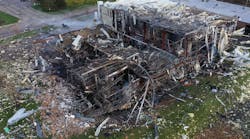Chemical Safety Board Provides Insight Following AB Specialty Silicones Explosion
The U.S. Chemical Safety Board (CSB) has released a factual update following the May 3, 2019 explosion at a facility in Waukegan Ill.
Four workers were killed at AB Specialty Silicones, a silicon chemical products manufacturer: 53-year-old Byron Biehn, the company's owner; 29-year-old Allen Stevens, owner and chemical operator; 57-year-old Jeff Cummings, production supervisor; and 24-year-old Daniel Nicklas, quality control chemist.
“We are shocked and heartbroken by the tragedy that occurred in our plant on May 3rd," General Manager Mac Penman posted on the company's website following the incident. "We are trying our best to support all of the members of our AB family as we attempt to process this terrible loss together.”
OSHA investigators found AB Specialty Silicones failed to ensure that electrical equipment and installations in the production area of the plant complied with OSHA electrical standards and were approved for hazardous locations. The company also used forklifts powered by liquid propane to transport volatile flammable liquids, and operated these forklifts in areas where employees handled and processed volatile flammable liquids and gases, creating the potential for ignition. The agency fined the company $1.59 million in penalties.
"Employers must employ hazard recognition to protect workers from harm, especially in high hazard industries," said Principal Deputy Assistant Secretary of Labor for Occupational Safety and Health Loren Sweatt. "By ignoring safety and health requirements, this employer created an unsafe work environment with deadly consequences."
The CSB's 22-page assessment provides a closer look into the events that led up to the incident. Information was gathering through witness statements and physical evidence.
On the date of the explosion and fire, AB Specialty Silicone workers were producing a batch of EM 652. The chemical is a trade name for a silicon hydride emulsion that is used as a water repellent. One of the raw materials used in production process is XL10, a compound along with EM 652 that creates flammable hydrogen gas.
During the second batch of the night, an operator noticed an anomaly in the production process and began yelling shortly before 9:30 p.m. A second worker and the shift supervisor responded to the emulsions area and discovered a tank overflowing with foam.
The operator told the other workers that he had just added the first two raw materials of the process into the tank, including XL 10.
While the operators and the shift supervisor were discussing the situation, the tank made a “very strange sound” and “erupted,” according to witnesses. The scene as the material overflowed from the tank was described as "hot" and "smoky."
At that point, the shift supervisor ordered workers to turn on exhaust fans. Before the fans were activated, the building exploded. According to the CSB, the explosion was felt up to 20 miles away in neighboring communities and damaged surrounding businesses.
The CSB investigation remains ongoing. The reconstructed timeline provided the following details for further analysis:
- The instructions to make EM 652 warn of the dangers of the production of hydrogen gas when XL 10 is in contact with acids or bases.
- The EM 652 was made in a set of two atmospheric tanks that were loosely sealed. Workers would open the top of these tanks during the production process to, among other things, perform visual observations. These tanks had no engineered system to direct flammable gas, including hydrogen, to a safe location.
- The building ventilation system likely caused the flammable gas cloud to mix with air and disperse throughout the building.
- Finally, the CSB determined that there were no flammable gas detectors or hydrogen gas detectors with alarms to warn workers of the significant hazard. The generation of gas in the emulsions tank could produce foaming; however, foaming does not normally occur during this portion of the EM 652 process. The placement of the main air mover near the EM 652 process further increased the potential explosion danger from flammable gases generated in the emulsions area.
“The CSB’s ongoing investigation will establish how a similar incident can be prevented," stated CSB Interim Executive Dr. Kristen Kulinowski. "To date, the agency has determined important details about this tragic explosion that destroyed the facility and took the lives of four workers. Ultimately, we will find the root cause and issue safety recommendations to prevent a similar incident.”
